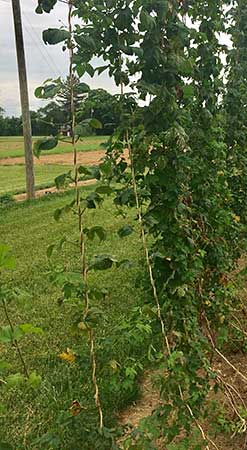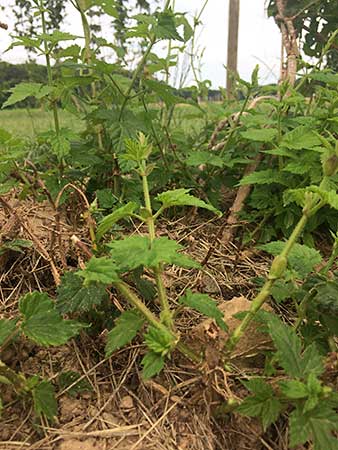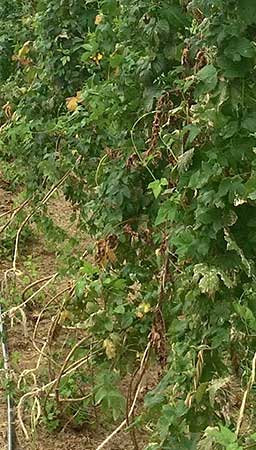Fact Sheet FS1282
Introduction

Figure 1. The hop "bine" that wraps around the guide string. (Photo by William Bamka)
Hop (Humulus lupulus) producers have long battled the disease downy mildew (Pseudoperonospora humuli). Downy mildew is one of the factors (in addition to prohibition) that contributed to driving large scale commercial hops production from New York State to the Pacific Northwest. With considerable interest in small scale-hop production in New Jersey and throughout the region, growers need to be aware of the potential threat of downy mildew impacting their crop. In New Jersey, just as in the Pacific Northwest, downy mildew has shown to be a continued problematic disease in hop yards. Yield and quality losses from downy mildew vary depending on susceptibility of the variety and timing of infection. Severity may range from non-detectable to 100% crop loss if significant cone infection occurs or entire plant death if whole plants are infected.
No single management tactic provides satisfactory control of downy mildew. Careful attention to cultural practices, irrigation management, and timely fungicide applications are needed to manage the disease successfully. Hop downy mildew flourishes mainly due to high humidity and temperature conditions during most summer months in the Mid-Atlantic region. Since this disease, once established, remains in the plant, on plant debris, and overwinters on plant tissue, it is difficult to eradicate once established in hop yards. Although no hop varieties are completely resistant, varieties vary in susceptibility to this disease. Keeping infection levels low and preventing spread to new growth is critical to managing the disease. To understand prevention, it is important to understand the disease cycle of Pseudoperonospora humuli; the causal agent of downy mildew in hop and hemp.

Figure 2. The "spike," or growing tip of a hop plant. (Photo by William Bamka)
Downy Mildew Disease Cycle
Pseudoperonospora humuli overwinters in buds and crowns of the hop plant or in leftover plant debris (e.g., infected leaves and stems) left in the yard. As shoots emerge in the spring, they may already be infected with overwintering mycelium from the previous season. As the hop bine (the flexible, wrapping stem of the hop plant, Figure 1) begins to grow, the mycelium produces a microscopic spore-bearing structure (sporangiophore) on the underside of leaves, giving the underside a gray, fuzzy appearance. These structures give rise to sporangia which produce zoospores. Zoospores are disseminated via wind and rain and act as a major cause of disease-spread during the season, infecting new leaves, shoots, and eventually even cones. Sporangia and zoospores may develop multiple times over the growing season, depending on temperature and moisture.
Wet weather that is the result of rain, dew, fog, or overhead irrigation coupled with temperatures in the range of 60–68°F is the optimum environment for downy mildew proliferation and infection. Managing soil moisture with drip irrigation is recommended for hop yards for this reason.

Figure 3. Wilted leaves infected with downy mildew. (Photo by William Bamka)
Symptoms
Infection generally occurs on new growth shoots. The new growth of a hop plant is termed a "spike" (Figure 2). Spikes can grow at the top of the plant or on side branches. Spikes infected with downy mildew will be stunted, have shortened internodes (space between buds), with leaves that turn yellow and later become brown, brittle and curl downward (Figure 3). In severe cases, infection can stop growth of top spikes, causing trained bines to fall off. Infection can also be seen on cones. Portions of cones or entire cones may exhibit dark brown areas, shrivel, dry up, and may even fall off. A diagnostic feature of hops downy mildew is the production of gray, fuzzy growth (spores) that only appears on the bottom side of infected leaves.
Management and Control
Preventative strategies to reduce the possibility of having a hop yard infected with downy mildew is important. First and foremost is selecting varieties with downy mildew tolerance. However, due to market demands for specific varieties, this is not always possible since brewers will be looking for flavor and not disease tolerance when demanding hop varieties. Additionally, no variety is completely resistant to downy mildew. See Table 1 for a listing of some hop varieties and downy mildew tolerance or susceptibility.
| Hop Variety | DM Tolerant | DM Susceptible |
|---|---|---|
| Cascade | X | |
| Cluster | X | |
| Fuggle | X | |
| Galena | X | |
| Hallertauer | X | |
| Hersbrucker Spalt | X | |
| Mittlefruh | X | |
| Nugget | X | |
| Perle | X | |
| Tettnanger | X | |
| Willamette | X |
New varieties are continually being developed and evaluated all the time. Unfortunately, disease tolerance is generally not a priority. New hop varieties are typically being selected based on flavoring they will provide in the beer-making process.
Practicing good sanitation in the hop yard is extremely important for future health and viability of this perennial crop. Any leftover refuse from harvest and uncut bines should be removed from the yard. Movement of infected material may spread pests and diseases to unaffected areas of the yard, so waiting until after freeze kill will lessen movement of any live insects or pathogens. The waste collected can be burned to eliminate infected debris. A 30-day infested plant material open-burning permit can be obtained for a small fee from the NJ Department of Environmental Protection's Forest Fire Service. The application must be signed by your county extension agricultural agent certifying the disease infection. Permit requests are then sent by the applicant to the Forest Fire Service in your region for approval. The permit forms are available from your local Rutgers NJAES Cooperative Extension office. See njaes.rutgers.edu/county for the location in your county.
Newly planted yards should be free of infection. If the environment is right, the disease is present, and the host susceptible, infection is likely inevitable. Starting regular preventative fungicide applications after active growth beings in spring is recommended, especially if the disease has been identified in the area or weather conditions are favorable for disease development. Properly applying fungicides labeled for downy mildew control in hop yards will be necessary to reduce disease levels and to produce a marketable crop. There are downy mildew prediction models used for hop yards in some areas of the U.S. Currently no model specific to New Jersey hops production is available. Rotation of fungicide chemistry is important to reduce the possibility of the fungus becoming resistant to certain classes of fungicides.
No data currently exists to suggest that post-harvest foliar treatments for downy mildew are beneficial in terms of disease reduction for the next season (Lizotte, 2014). One possible approach would be to use systemic fungicides post-harvest; however, no research has been done to prove effectiveness for the following season.
In summary, starting with clean plant material, maintaining healthy plants, practicing good sanitation, and applying preventative fungicides is the best way to protect against downy mildew infection in hop yards.
References
November 2017
Copyright © 2024 Rutgers, The State University of New Jersey. All rights reserved.
For more information: njaes.rutgers.edu.
Cooperating Agencies: Rutgers, The State University of New Jersey, U.S. Department of Agriculture, and Boards of County Commissioners. Rutgers Cooperative Extension, a unit of the Rutgers New Jersey Agricultural Experiment Station, is an equal opportunity program provider and employer.

